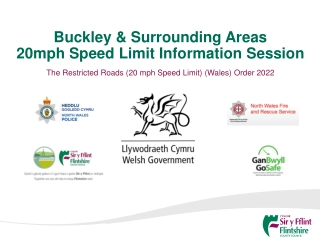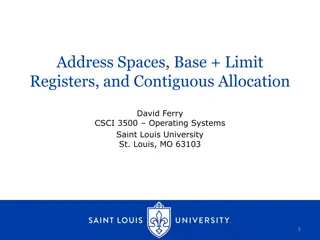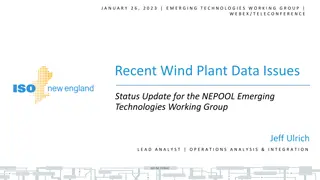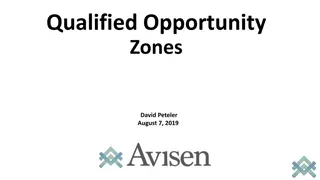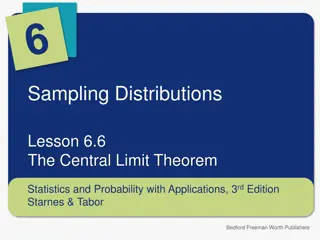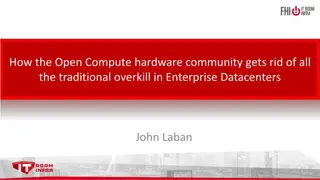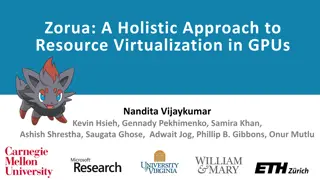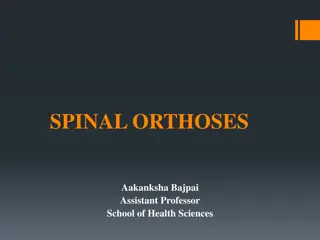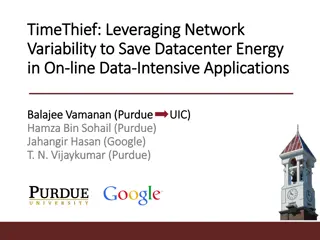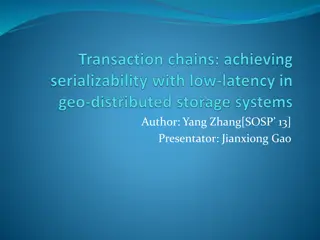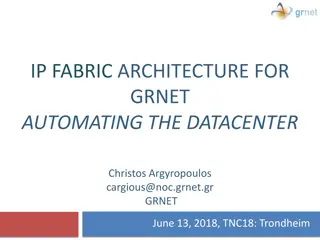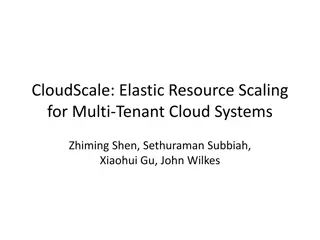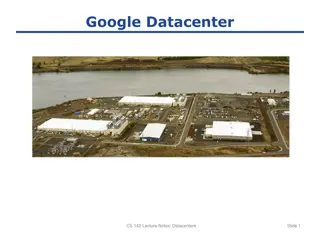Resource Overcommitment in Datacenters: The Limit and Opportunity
Exploring resource overcommitment in datacenters, this study delves into the benefits of overcommitting resources beyond physical capacity to increase utilization and reduce costs. With a focus on peak prediction-driven strategies and setting the right level of overcommitment, the research highlights the potential for optimizing resource allocation in datacenter environments.
Download Presentation

Please find below an Image/Link to download the presentation.
The content on the website is provided AS IS for your information and personal use only. It may not be sold, licensed, or shared on other websites without obtaining consent from the author.If you encounter any issues during the download, it is possible that the publisher has removed the file from their server.
You are allowed to download the files provided on this website for personal or commercial use, subject to the condition that they are used lawfully. All files are the property of their respective owners.
The content on the website is provided AS IS for your information and personal use only. It may not be sold, licensed, or shared on other websites without obtaining consent from the author.
E N D
Presentation Transcript
Take it to the Limit: Peak Prediction-driven Resource Overcommitment in Datacenters Noman Bashir1, Nan Deng2, Krzysztof Rzadca2,3David Irwin1, Sree Kodak2, Rohit Jnagal2 1 1 University of Massachusetts Amherst, 2Google, LLC, 3University of Warsaw, Poland
Each task has a limit on how many resource it can use, aka allocated resources. Set by the user or an entity outside Borg, e.g., Autopilot [EuroSys 20]. internal users tasks Step 2: packing bins Step 1: finding bins bin right packing algos hardware? BorgMaster got Well- studied permissions? free NP-hard capacity? without overcommit, sum of allocated resources machine s physical capacity 2 Disclaimer: this is a simplified architecture for illustration purposes only, please see the Borg papers [EuroSys 15, 20] for details.
Committed to overcommit Overcommitment: sum of allocated resources > machine s physical capacity A solution to increasing resource utilization and reducing costs. Used by many datacenter schedulers, e.g., Borg, Azure s VM scheduler. Supported by many cloud resource management platforms. 3
A brief overview of overcommit opportunity Overcommit scenario: allocations 100%, utilization is < 100%. Overcommit opportunity machine s capacity resource usage Usage to limit gap: allocations to satisfy expected peak demand. Pooling effect: peaks rarely coincide due to statistical multiplexing. 0.3 0.42 Autopilot [EuroSys ??] targets reducing this gap sum(machine level peak) sum(task level peak) 4
Setting the right level of overcommit State of the art policies typically overcommit by a fixed margin e.g., borg s default policy uses fixed overcommit factor. ignore the machine s resource usage; risky and wasteful. Level of overcommitment Overcommitment zero low high Allocation level physical capacity > physical capacity >>> physical capacity Resource wastage high low very low Perf. impact none less likely highly likely No evictions or performance degradation + maximum savings while being safe 5
Overcommit as the problem of finding free capacity Overcommit problem is the problem of finding free capacity on each machine it is complementary and orthogonal to scheduling problem. bin packing algos right hardware? finding bins got permissions? Well-studied free capacity? NP-hard overcommitment level? packing bins 6
Key contributions Formalize the overcommitment problem using first-principles. 1. Propose a general methodology of designing and evaluating overcommit policies. 2. Provide the tools (software and dataset) for people to follow the same methodology. 3. 7
Overcommitment as a peak-prediction problem Finding available capacity of bins is a systems problem (generally) e.g., in Borg, scheduler polls the machines for free capacity. Let s assume there is oracle free (x) a single machine with one task running machine s capacity Future resource allocation is 100% scheduler asks for free capacity t =- t = now t = Peak Oracle: provides future peak usage future knowledge; most savings; safest. 8
Practical peak predictors Peak oracle is impossible to implement in practice a supervised learning problem given history and peak oracle. enables the use of highly-available predictive tools. Production environment puts additional constraints max(predictors) e.g., low CPU and memory footprint. peak = max(peaks across predictors) Example predictors from the paper very simple predictors with room for improvement. borg-default RC-like N-sigma Inspired by Borg peak = fraction of sum of limits Inspired by Resource Central peak = sum(x %ile of tasks usage) based on central limit theorem peak = mean + N times STD 9
Designing and evaluating practical peak predictors Our problem formulation enables us to design, tune, and evaluate predictors in simulation quickly iterate through multiple designs and scheduling scenarios. avoid conducting risky and time-consuming experiments in production. End of Horizon t = 0 Start of History compare practical peak predictor peak oracle maximum(usage) predicted peak We release our simulator s code under free and open-source license1 enables future work on designing and evaluating overcommit policies. standardized interface enables easy integration into Borg/K8s-like platform. 1https://github.com/googleinterns/cluster-resource-forecast 10
Measuring overcommit quality in simulation Classic prediction quality metrics, e.g., MAPE/MSE, are not directly applicable special cases apply for over, under, and correct predictions. savings? prediction is it safe? final verdict? oracle violation? > oracle very safe low acceptable no = oracle safe high desirable no < oracle no high dangerous yes Violation rate: ratio of oracle violations and total time instances higher the violation rate, higher the risk to the machine. Based on SLOs certain level of violation rate may be acceptable. 11
Violation rate and in-production tasks performance Quality of Service (QoS) in production CPU scheduling latency wait time for a ready process low is better for serving tasks 1% increase in violation rate leads to 14.1% increase in CPU scheduling latency 12
Evaluation setup In-simulation: using version 3 of the Google s public cluster trace [EuroSys 20] tune policy parameters, compare peak predictors. In-production: datacenters running Google s serving workloads multiple weeks and ~24,000 machines across the globe. an A/B experiment comparing against Borg s default. simulation metrics definition additional production metrics # of violations / total timestamps Increase in advertised free capacity violation rate violation severity max(0, oracle peak) Increase in allocations & workload CPU scheduling latency saving ratio (limit peak)/limit 13
Tuning practical peak predictors Tuning of N-Sigma peak predictor predicted peak = mean + n x std parameters: n, warm-up, history Performance vs. savings tradeoff n , savings , performance 14
Comparing practical peak predictors better better Probability(per-machine violation rate x) Probability (saving ratio x) Max predictor balances savings and performance. RC-like N-Sigma max(N-Sigma, RC-like) borg-default RC-like N-Sigma max(N-Sigma, RC-like) borg-default x - Per-machine violation rate x- Per-cell saving ratio RC-like predictor saves more but yields low performance 15
Savings and workload increase in production more advertised capacity more tasks allocations increase in workload better 16
Improvement in performance Production results match simulation similar per-machine violation profile. violation rate and CPU scheduling latency have same profiles. Experiment group shows better performance than control group. better 17
Improvement in performance (continued) average utilization 99p utilization Improved performance at higher workload machine utilization on average is higher. machine utilization at 99p is lower. Performance improves due to per-machine overcommitment settings high utilized machines face less overcommitment and vice versa. high utilization 18
A few pointers before I let you go Key takeaways from the talk proposed a general methodology for designing and evaluating overcommit policies. established a correlation between simulation results and performance in production. demonstrated that our simple peak predictors outperform state of the art. Potential future work significant room for improvement in our practical peak predictors. testing more sophisticated, but lightweight, machine learning algorithms. Want to use our simulator? Code: https://github.com/googleinterns/cluster-resource-forecast Data: https://github.com/google/cluster-data Documentation: https://github.com/googleinterns/cluster-resource-forecast/docs Help: Noman Bashir (nbashir@umass.edu) 19



